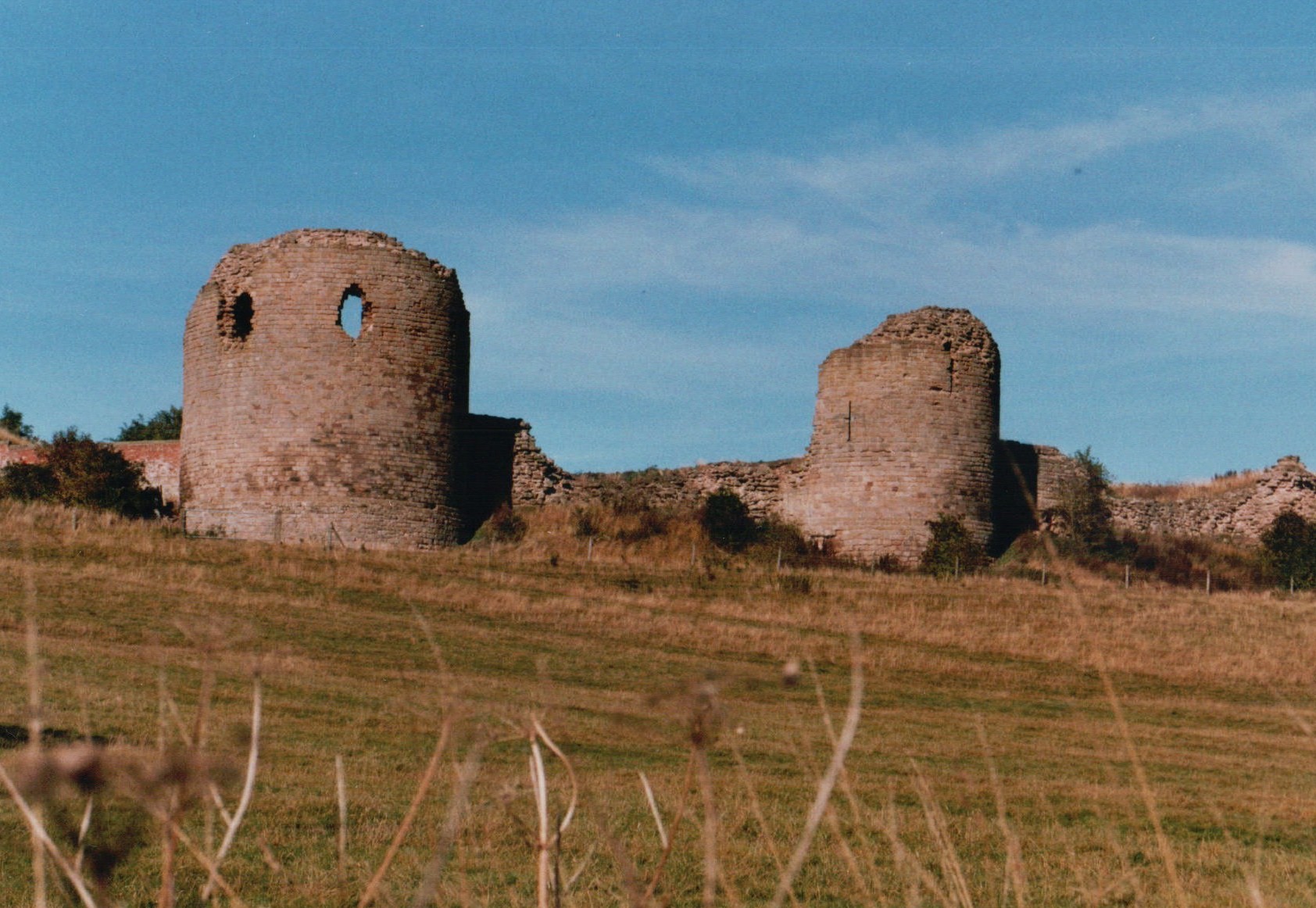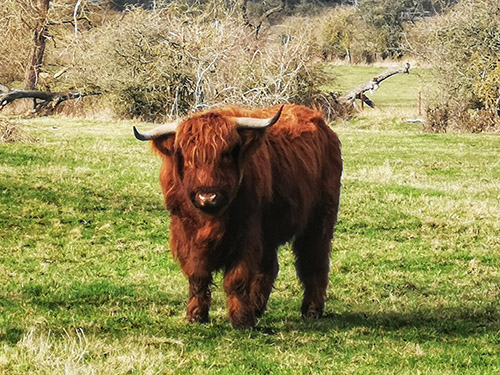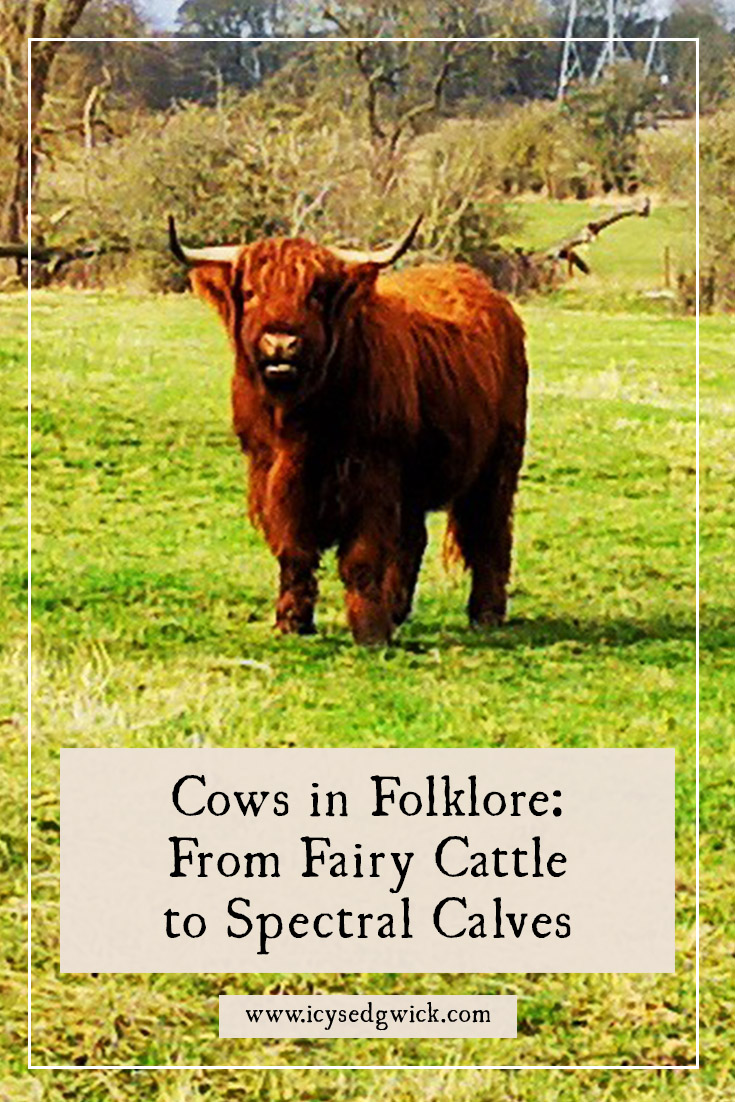Certain animals might spring to mind when it comes to folklore. Hares, horses, deer, cats – they all have an otherworldly quality to them. Would you consider the same of cows?
There’s a surprising amount of folklore about cows. They can be death omens, fairy cattle, consumption cures, or even the guardians of treasure. That’s not even considering the deities associated with cows, or their appearance in mythology. Just look at the various versions of the Taurus origin myth.
We’ve looked at the tarbh-uisge before, the water-bull from Scottish folklore, so we won’t cover it again here. You’ll find a tale of the tarbh-uisge in the Islay folklore article. There is also a lot of folklore about cattle in Irish myth and legend, but the Irish Pagan School have a class on that if you want to know more. This post will predominantly focus on English folklore BUT I’d love to hear if you’ve heard similar legends to these where you are. They comprise particular story types and I’d be keen to see how and where they travelled to!
Cows as Death Omens
We’re off to the now-ruined Chartley Castle in Staffordshire to investigate a rather interesting herd of cattle. They were small, white, and had black tips on their horns, with black muzzles. Some thought they descended from prehistoric wild cattle. The Chillingham cattle are often used as a comparison (Harper 1907: 262). Interestingly, the inside and part of the outside of the ear was red, which makes them sound more like fairy cattle (Westwood 2005: 662).
But in the 19th century, a legend began that the birth of black calves heralded death for one of the Ferrers family who lived at the castle. The legend claims that this tradition dated to the 13th century. Apparently, such a calf was born and a few months later, a member of the Ferrers family was killed in the battle of Burton Bridge (Harper 1907: 260).

In his book, Haunted Houses: Tales of the Supernatural (1907), Charles G. Harper refers to an article published in 1842 in the Staffordshire Chronicle which apparently linked seven black calves with seven deaths in the family, from 1827 to 1835. I looked for this article, but the British Newspaper Archive only have the Staffordshire Chronicle going back to 1887. No 1842 articles about death omens for me, then!
For such an apparent ancient tradition, no one mentioned it before the 19th century. Even Harper notes the fact that there was no mention of a black calf born around 1760 when Earl Ferrers was hanged for murder (Harper 1907: 260). Belief in the omen faded throughout the 19th century, possibly due to the better genetic mixing of the cattle.
Surprisingly, it’s not the only story involving cows as death omens. In 1850, someone reported that three cows got into their garden, and they had three deaths in the next six months. It seems people believed death followed if a cow got into your garden (Opie 2005: 103).
The Chillingham Cattle
Speaking of the Chillingham Cattle, they’re a wild herd that lives in the grounds of Chillingham Castle. According to legend, they are the descendants of the cattle that roamed across Britain when the Saxons arrived (BEFORE TOO LATE 1940: 4). There’s another suggestion that the Vikings brought them when they arrived, due to genetic similarities between the cattle and a Swedish breed (Medieval Histories 2023). They’ve never been managed by humans so they’re incredibly inbred. With less than 150 animals, they’re rarer than pandas and mountain gorillas (Brown 2023).
Famed northern engraver Thomas Bewick created a print of one of the cattle, ‘The Wild Bull’, in 1789. This is a metal plaque that shows Bewick’s engraving. The plaque was made in 2003 and installed by the Bewick Society on what is now Bewick Street to mark Bewick’s 250th birthday. He lived near the spot where you’ll find the plaque from 1781 until 1812.
The Roaring Bull of Bagbury
This legend comes from Shropshire, and it was collected by Charlotte Burne in the 1880s. It begins with an odious squire, who worked his men hard and treated them ill. He had only ever done two good deeds in his life, giving a poor man a waistcoat, and a poor boy some bread and cheese.
After he died, he reappeared as a massive bull with a fearsome temper. The spectre haunted the farm, roaring so hard that the tiles and shutters broke free from the building. Sometimes, he appeared as a ‘dark man’, and a servant watched this figure walk through the back door, and then out of the front, with the doors flying open despite being locked. No matter how often the servant locked the doors, the figure blew the locks open again as he passed through the house. Jennifer Westwood suggests a demonic aspect to the figure (2005: 613).
There was nothing else for it; they needed to lay the ghost. A group of parsons, either nine or twelve, gathered in Hyssington Church. They carried lit candles, ready to pray the ghost away. The Bull rushed into the church, blowing out all but one of the candles. An old parson had kept the candle inside his boot, so it remained lit, and the others used it to relight their candles.
As they prayed, the Bull grew smaller and smaller, and smaller still. Eventually, their prayers made him small enough to fit inside a snuff box. The Bull asked to be buried under the bridge so he could cause every mare to lose her foal, and any woman to lose her child. The parsons declined the request and threw the box into the Red Sea. As far as anyone knows, it remains there still (Westwood 2005: 614).
Counter-Witchcraft Cows
While the previous story sees an evil, wicked man take the form of a bull to persecute his community after death, a tale from Warwickshire sees cow body parts used for counter-witchcraft.
In the 1880s, in Willington, a farmer noticed illness spreading through his cow herd. Sensing this was witchcraft rather than a normal disease, he removed the heart from one of them. He stuck it all over with pins and roasted it.

A weird animal like nothing he’d seen before appeared at the kitchen door, trying to reach the heart, but the farmer had had the forethought to bar the door.
After some time, the weird animal died at the door, and soon after, the cows recovered. Such apotropaic practices appear elsewhere in English folk magic. We can’t know if the weird animal was the witch who cursed the cows, or her familiar. Either way, destroying the heart destroyed the curse (Westwood 2005: 759).
Treasure Hunting Calves
There’s a fascinating legend from the old county of Westmorland, involving Hackthorpe Hall. By the early 19th century, the hall had become a farmhouse. A spectral calf appeared to the tenant farmer one day, and led the farmer to a stone cattle-trough.
Beneath it, he discovered a cache of hidden gold. There was enough to pay for two estates (Westwood 2005: 768). It’s unclear why a calf would be the guardian of such gold. Perhaps the guardian merely took the form of a calf as it was a familiar animal to the farmer. Or maybe it chose as unthreatening an animal as possible.
The Dun Cow of Various Legends
Various stories around Britain explore the idea of a supernatural cow whose milk never ran out each day. During a famine, the locals could still access milk, and so the cow saved their lives. Unfortunately, one person turned up with a sieve, and milked the cow into the sieve, rather than a bucket. Since the sieve could never be filled, the milk ran out.
In other versions, the cow goes on a murderous rampage in the area. One such version is the Dun Cow of Warwick, said to stand 3.6 m high with flaming red eyes. This story attributes the slaying of such a dangerous beast to the famous adventurer, Sir Guy of Warwick, who kills her on Dunsmore Heath. In 1552, Dr Caius described seeing bones from an enormous animal in Warwick, said to be those of the Dun Cow. One rib alone was 1.8 m long (Westwood 2005: 758).

Another dun cow appears in Lancashire, roaming the moors of Bowland, Browsholme, Parlick and Bleasdale. People from the area could milk this cow, and she’d fill any pail to the brim. Eventually, a witch from Pendle brought a sieve, and the cow produced milk all day, yet could not fill the sieve. The cow disappeared, leaving the community without her seemingly inexhaustible milk supply (Westwood 2005: 411). An old house on the outskirts of Longridge displayed a large bone over the main entrance and claimed it was one of this dun cow’s ribs. Folklorists John Harland and T. T. Wilkinson said it was part of a whale’s jaw (Westwood 2005: 411).
The version told in South Lopham in Norfolk adds another layer since a rock known as the Oxfoot Stone was said to hold the impression of a cow’s hoof. According to the legend, the dun cow kicked the stone when her milk ran dry, before she disappeared (Westwood 2005: 514).
In the version of the legend from Stanion in Northamptonshire, which also features a giant bone in the church said to be from the cow, she died of a broken heart after being unable to fill the sieve (Westwood 2005: 541).
Mitchell’s Fold
Among these various tales of magical cows, I wanted to highlight one from Shropshire. A stone circle on Corndon Hill near Chirbury has been called Mitchell’s Fold since around 1840. Likely dating to the early Bronze Age, the circle attracted various stories among local people. In one legend, a giant used the circle as a pen to milk his cows. Antiquarian William Stukeley thought druids used the circle as a temple, though to be fair, Stukeley could probably squeeze druids into almost anything.

Yet the most popular version of the legend saw the fairies sending a cow to the area to help the locals during famines. She always appeared at Mitchell’s Fold every morning and night, and as long as people only took one pail of milk, she never ran dry, no matter how many people milked her.
Eventually, the old witch Mitchell came along, filled with spite and resentment. She milked the cow into a sieve, that the cow clearly couldn’t fill. The cow disappeared and no one ever saw her again. Some even thought she went on to become the wild dun cow killed by Sir Guy of Warwick.
The witch was turned to stone as a punishment, and the other stones are there to keep her in place. So the pen is not a fold belonging to Mitchell, but rather a fold enclosing Mitchell (Westwood 2005: 626).
Folk Remedies
My favourite part of the sheep folklore post was the sheer number of folk remedies involving sheep. It turns out cows also appear in some, and these remedies also involve respiratory complaints!
In 1851, those with pulmonary issues were recommended to sleep in a room above the place where cows were kept. In Pembrokeshire, one butcher recommended that if you had tuberculosis, you should stick your head into a freshly slaughtered carcass and inhale. Even as late as the 1980s, people believed anyone who lived within the smell of a cow yard wouldn’t get tuberculosis (Opie 2005: 103).

We should also thank cows for the smallpox vaccine. In the 18th century, Edward Jenner noticed that milkmaids often caught cowpox from the cows, but didn’t catch smallpox once they’d done so. He wondered if cowpox could somehow ward off smallpox. In 1796, he used material from a cowpox sore to inoculate an eight-year-old boy. The boy got mild cowpox but made a complete recovery. Jenner then exposed him to smallpox, and the boy proved immune to it. Jenner went on to test the theory repeatedly, laying the foundation for the smallpox vaccine (Vaishali 2024). The World Health Assembly declared the world free of smallpox in May 1980.
Have you heard legends like this?
As I said in the intro, I would love to hear if you’ve heard similar legends where you are. It would be interesting to see how and where these stories travelled to, and how they changed once they ended up somewhere new! Feel free to leave a comment below if you’ve heard such stories in your neck of the woods.
References
BEFORE TOO LATE (1940), ‘The Chillingham Cattle’, Northern Whig, 6 February, p. 4.
Brown, Mark (2023), ‘‘They are formidable creatures’: life with Northumberland’s rare white wild cattle’, The Guardian, 26 March, https://www.theguardian.com/environment/2023/mar/26/chillingham-northumberland-wild-cattle. Accessed 3 February 2025.
Harper, Charles G. (1907), Haunted Houses: Tales of the Supernatural, Philadelphia: J.B. Lippincott Company.
Medieval Histories (2023), ‘Wild Cattle in Britain – Descendants of Viking Cattle?’, Medieval Histories, https://www.medieval.eu/wild-cattle-in-britain-descendants-of-viking-cattle/. Accessed 3 February 2025.
Opie, Iona and Moira Tatem (2005), Oxford Dictionary of Superstitions, Oxford: Oxford University Press (affiliate link).
Vaishali, Pooja Mary, and Nisha Boopathy (2024), ‘Edward Jenner: The Pioneer of Vaccination and His Enduring Legacy in Modern Medicine’, Cureus, 16(9).
Westwood, Jennifer and Simpson, Jacqueline (2005), The Lore of the Land: A Guide to England’s Legends, London: Penguin.
Nutty about folklore and want more?
Add your email below and get these posts in your inbox every week.
You'll also get my 5-step guide to protecting your home using folklore!









I live in the Alps and our Folklore is full of cattle.
There are ghostly bulls that are the ghosts of dairymen who mistreated cattle during their lifetime, doomed to roam the mountain pastures they once worked on until someone releases them by doing the same thing to them as they did to deserve the punishment.
It‘s also said that if you enter the cowshed at midnight on Christmas Eve, you will hear the cows talking about what‘s going to happen next year. Except you shouldn‘t because you might not like what you hear.
Oh wow – those ghostly bulls don’t sound fun. But I’m fascinated by the idea of gossiping cows!
And here I am in Mount Jackson, VA, USA with a random 1885 chromolithograph of Chillingham cattle that I picked up at a local auction because it was handsome. It shows a white bull, cow and calf against a wooded backdrop. Published by Selmar Hess, N.Y. from Animate Creation by William Wood. L. Prang and Co., Boston. It will now have a new and fascinating story thanks to your research, Icy. Thank you! Sorry no cow tales to share, in spite of knowing several northern Minnesota dairy farmers in my childhood. But they were a pragmatic lot.
The Chillingham cattle are definitely a fascinating group of animals!